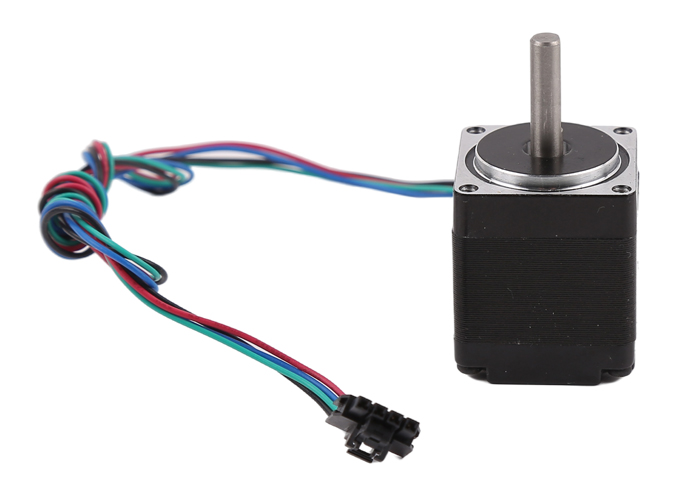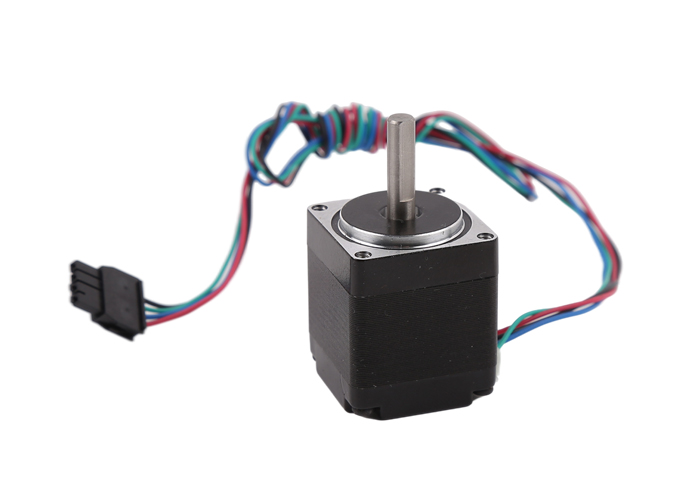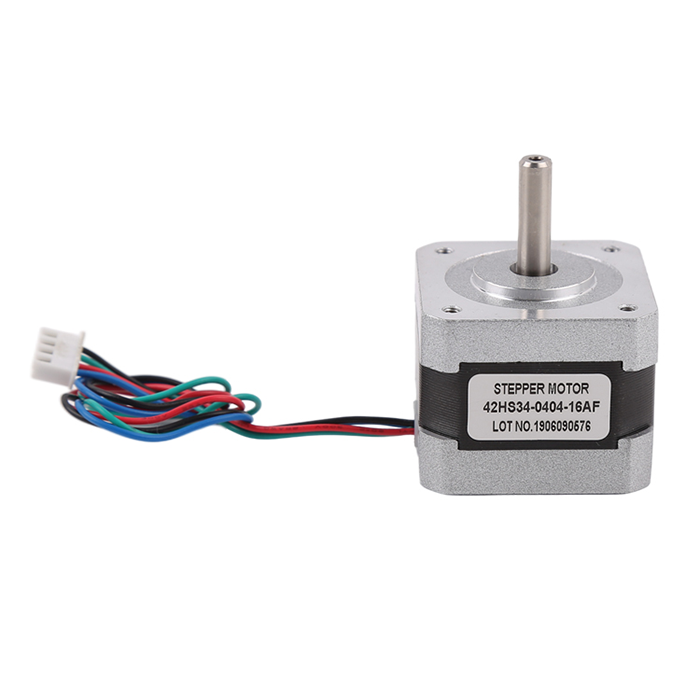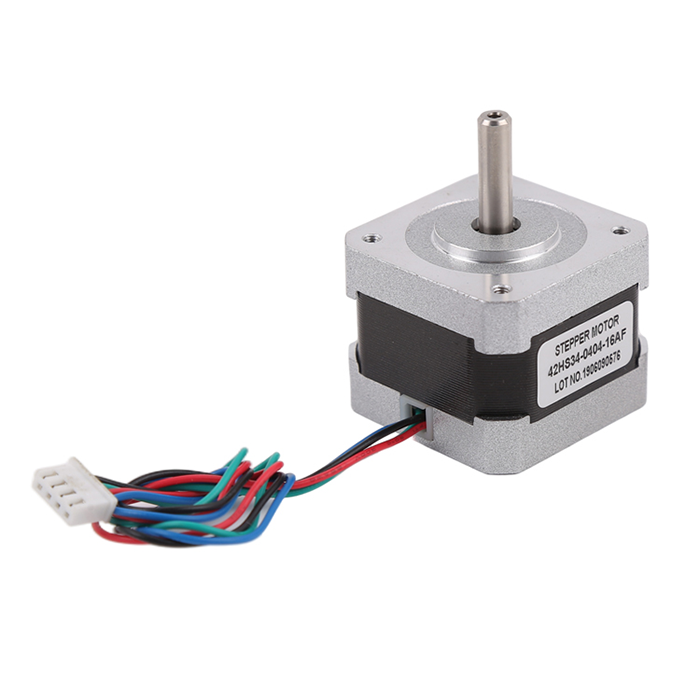28 قەدەملىك ماتور كىچىك پەلەمپەيسىمان ماتور بولۇپ ، ئۇنىڭ نامىدىكى «28» ئادەتتە ماتورنىڭ سىرتقى دىئامېتىرى 28 مىللىمېتىرنى كۆرسىتىدۇ. پەلەمپەيسىمان ماتور ئېلېكتر تومۇر سىگنالىنى ئېنىق مېخانىكىلىق ھەرىكەتكە ئايلاندۇرىدىغان ئېلېكتر ماتورى. ئۇ بىرلا ۋاقىتتا بىر تومۇر سىگنالىنى قوبۇل قىلىپ ، روتورنى مۇقىم بۇلۇڭ (ھەرىكەت بۇلۇڭى دەپ ئاتىلىدۇ) ئارقىلىق ھەرىكەتلەندۈرۈش ئارقىلىق ئېنىق ئورۇن كونترول قىلىش ۋە سۈرئەت كونترول قىلىشنى ئەمەلگە ئاشۇرالايدۇ.
In 28 قەدەملىك ماتور، بۇ كىچىكلىتىش ئۇلارنى بوشلۇق چەكلىك ۋە ئىش ئورنىنى ئاپتوماتلاشتۇرۇش ئۈسكۈنىلىرى ، ئېنىق ئەسۋابلار ، ئېلېكترونلۇق ئۈسكۈنىلەر ، 3D بېسىش ئۈسكۈنىلىرى ۋە يېنىك تىپتىكى ماشىنا ئادەملەر قاتارلىق بوشلۇق چەكلىك ۋە ئېنىق ئورۇن بەلگىلەشنى تەلەپ قىلىدىغان قوللىنىشچان پروگراممىلارغا ماسلاشتۇرىدۇ. لايىھەگە ئاساسەن ، 28 پەلەمپەيسىمان ماتورنىڭ ئوخشىمىغان قەدەم بۇلۇڭى (مەسىلەن ، 1.8 ° ياكى 0.9 °) بولىدۇ ھەمدە ئوخشىمىغان باسقۇچتىكى (ئىككى باسقۇچلۇق ۋە تۆت باسقۇچلۇق كۆپ ئۇچرايدىغان) ئايلانما ئىقتىدارلار بىلەن تەمىنلىنىشى مۇمكىن. ئۇنىڭدىن باشقا ، 28 باسقۇچلۇق ماتور ئادەتتە شوپۇر بىلەن ھازىرقى سەۋىيىنى تەڭشەش ۋە كونترول ھېسابلاش ئۇسۇلىنى كونترول قىلىش ئارقىلىق ماتورنىڭ مەشغۇلات ئۈنۈمىنى ئەلالاشتۇرۇش ئۈچۈن ئىشلىتىلىدۇ.
42 پەلەمپەيسىمان ماتورنىڭ چوڭ-كىچىكلىكى ئۆلچەمدىكى قەدەم باسقۇچلۇق ماتور بولۇپ ، ئۇنىڭ نامىدىكى «42» ئۇنىڭ تۇرالغۇ ياكى ئورنىتىش فاڭجېننىڭ 42 مىللىمېتىر دىئامېتىرىنى كۆرسىتىدۇ. پەلەمپەيسىمان ماتور ئېلېكتر تومۇر سىگنالىنى ھەرىكەتنىڭ ئېنىق قەدەم باسقۇچلىرىغا ئايلاندۇرىدىغان ئېلېكتر ماتورى بولۇپ ، كىرگۈزۈش تومۇرىنىڭ سانى ۋە چاستوتىنى كونترول قىلىش ئارقىلىق ماتور ئوقنىڭ ئايلىنىش بۇلۇڭى ۋە تېزلىكىنى كونترول قىلغىلى بولىدۇ.
42 قەدەملىك ماتورئادەتتە 28 قەدەملىك ماتور قاتارلىق كىچىك رازمېرلارغا سېلىشتۇرغاندا چوڭ-كىچىكلىكى ۋە ماسسىسى چوڭ بولىدۇ ، شۇڭلاشقا تېخىمۇ يۇقىرى بۇرۇلۇش مومېنتى بىلەن تەمىنلىيەلەيدۇ ، ئۇلارنى تېخىمۇ چوڭ توك قوزغاتقۇچ تەلەپ قىلىدىغان قوللىنىشچان پروگراممىلارغا تېخىمۇ ماسلاشتۇرىدۇ. بۇ ماتورلار ئاپتوماتىك ئۈسكۈنە ، 3D پىرىنتېر ، ماشىنا ئادەم ، ئېنىق ئەسۋاب ، سانائەت ئىشلەپچىقىرىش ئۈسكۈنىلىرى شۇنداقلا چوڭ ئىشخانا ئاپتوماتلاشتۇرۇش ئەسلىھەلىرى قاتارلىق كەڭ قوللىنىشچان پروگراممىلاردا ئىشلىتىلىدۇ.
42 Stepper ماتورئوخشاشلا لايىھەنىڭ ئوخشىماسلىقىغا ئاساسەن ئوخشىمىغان باسقۇچلارغا (ئادەتتە ئىككى ۋە تۆت) بۆلۈشكە بولىدۇ ھەمدە ئوخشىمىغان قەدەم بۇلۇڭى بىلەن تەمىنلەيدۇ (مەسىلەن 1.8 ° ، 0.9 ° ھەتتا كىچىكرەك بۆلەكلەر). ئەمەلىيەتتە ، تېخىمۇ ياخشى ئۈنۈمگە ئېرىشىش ئۈچۈن ، 42 قەدەملىك ماتور ماس كېلىدىغان قوزغاتقۇچ بىلەن بىرلەشتۈرۈپ ئىشلىتىلىدۇ. نۆۋەتتىكى ، ئىنتېرپوللاش ۋە باشقا پارامېتىرلارنى تەڭشەش ئارقىلىق ئۈنۈم ، راۋانلىق ۋە شاۋقۇننى پەسەيتىشكە بولىدۇ.
28 28 قەدەملىك ماتور بىلەن 42 قەدەملىك ماتورنىڭ ئاساسلىق پەرقى چوڭ-كىچىكلىكى ، بۇرۇلۇش مومېنتى ، قوللىنىشچانلىقى ۋە بىر قىسىم ئىقتىدار پارامېتىرلىرى:
1 ، چوڭلۇقى:
-28 پەلەمپەيسىمان ماتور: ئورنىتىش دائىرىسى ياكى تەگلىكى OD چوڭلۇقى تەخمىنەن 28 مىللىمېتىر كېلىدىغان پەلەمپەيسىمان ماتورنى كۆرسىتىدۇ ، بۇ كىچىكرەك ، بوشلۇق چەكلىك ، ھەجىمى ئىنتايىن مۇھىم بولغان پروگراممىلاردا ئىشلىتىشكە ماس كېلىدۇ.
-42 پەلەمپەيسىمان ماتور: ئورنىتىلغان فانتازىيىلىك ياكى OD چوڭلۇقى 42 مىللىمېتىرلىق پەلەمپەيسىمان ماتور ، 28 قەدەملىك ماتورغا سېلىشتۇرغاندا تېخىمۇ چوڭ ، تېخىمۇ چوڭ بۇرۇلۇش مومېنتى بىلەن تەمىنلەيدۇ.
2. Torque چىقىرىش:
-28 پەلەمپەيسىمان ماتور: كىچىكلىكى ۋە يېنىكلىكى سەۋەبىدىن ، ئەڭ چوڭ چىقىرىش بۇرۇلۇش مومېنتى ئادەتتە كىچىك بولۇپ ، يېنىك يۈك ياكى ئېنىق ئورۇن بەلگىلەشكە ماس كېلىدۇ ، مەسىلەن كىچىك ئۈسكۈنىلەر ، ئىنچىكە ئەسۋابلار ياكى ئىستېمال ئېلېكترونلىرى.
-42 قەدەملىك ماتور: بۇرۇلۇش مومېنتى بىر قەدەر چوڭ ، ئادەتتە 0.5NM غا يېتىدۇ ، ھەتتا ئۇنىڭدىنمۇ يۇقىرى بولىدۇ ، تېخىمۇ چوڭ ھەرىكەتلەندۈرگۈچ كۈچ ياكى تېخىمۇ يۇقىرى يۈك سىغىمى تەلەپ قىلىدىغان ئەھۋاللارغا ماس كېلىدۇ ، مەسىلەن 3D پرىنتېر ، ئاپتوماتىك ئۈسكۈنىلەر ، سانائەت كونترول سىستېمىسى قاتارلىقلار.
3. ئىقتىدار ئالاھىدىلىكى:
- ھەر ئىككىسىنىڭ خىزمەت پرىنسىپى ئوخشاش ، ھەم تومۇر سىگنالى ئارقىلىق بۇلۇڭ ۋە ئورۇننى توغرا كونترول قىلىدۇ ، ئوچۇق ئايلانما كونترول قىلىش ، جۇغلانما خاتالىق ۋە باشقا ئالاھىدىلىكلەر يوق.
-سۈرئەت بىلەن بۇرۇلۇش مومېنتى ئوتتۇرىسىدىكى مۇناسىۋەت ، 42 قەدەملىك ماتورنىڭ چوڭ-كىچىكلىكى ۋە ئىچكى لايىھىسى بىر قەدەر چوڭ بولغاچقا ، مەلۇم قۇۋۋەت چەكلىمىسى ئاستىدا تېخىمۇ يۇقىرى ۋە مۇقىم بۇرۇلۇش مومېنتى بىلەن تەمىنلىيەلەيدۇ.
4. ئىلتىماس قىلىش ئەھۋاللىرى:
-28 قەدەملىك ماتور كىچىكلىتىش ، تۆۋەن توك سەرپىياتى ۋە يۇقىرى ئېنىقلىق تەلەپ قىلىدىغان قوللىنىشچان مۇھىتقا تېخىمۇ ماس كېلىدۇ.
-42 قەدەملىك ماتورنىڭ چوڭ-كىچىكلىكى ۋە كۈچلۈك بۇرۇلۇش مومېنتى سەۋەبىدىن تېخىمۇ چوڭ ھەرىكەت ۋە ئىتتىرىشنى تەلەپ قىلىدىغان قوللىنىشچان پروگراممىلارغا تېخىمۇ ماس كېلىدۇ.
يىغىنچاقلىغاندا ، 28 قەدەملىك ماتور بىلەن 42 پەلەمپەيسىمان ماتورنىڭ پەرقى ئاساسلىقى فىزىكىلىق ئۆلچەم ، ئەڭ چوڭ تولغىنىش مومېنتى ۋە نەتىجىدە بېكىتىلگەن ئوخشىمىغان قوللىنىشچان رايونلاردا بولىدۇ. تاللاشتا بۇرۇلۇش مومېنتى ، سۈرئەت ، بوشلۇق چوڭلۇقى ۋە ئەمەلىي قوللىنىشتا تەلەپ قىلىنغان باشقا ئامىللارنىڭ بىرىكىشى ئاساس قىلىنىشى كېرەك.
يوللانغان ۋاقتى: 5-مايدىن 09-2024-يىلغىچە




